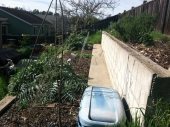









find religion! church
kiva! hyvä! iloinen! pikkumaatila
get stung! beehives
be hospitable! host-a-hive
be antisocial! facespace








Brenda
Bloom where you are planted.
http://restfultrailsfoodforestgarden.blogspot.com/








Brenda
Bloom where you are planted.
http://restfultrailsfoodforestgarden.blogspot.com/








rose macaskie wrote:
Please will someone explain keyhole beds, hozomeen who has made them would be good, i dont know about them, only what i observed in a video of bill mollison and guess work, i suppose i could look them up but if it can be explained here, well, that makes it easier. agri rose maccaskie.




"the qualities of these bacteria, like the heat of the sun, electricity, or the qualities of metals, are part of the storehouse of knowledge of all men. They are manifestations of the laws of nature, free to all men and reserved exclusively to none." SCOTUS, Funk Bros. Seed Co. v. Kale Inoculant Co.













Idle dreamer

|
I found some pretty shells, some sea glass and this lovely tiny ad:
Rocket Mass Heater Resources Wiki
https://permies.com/w/rmh-resources
|






